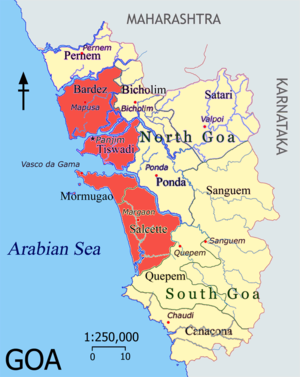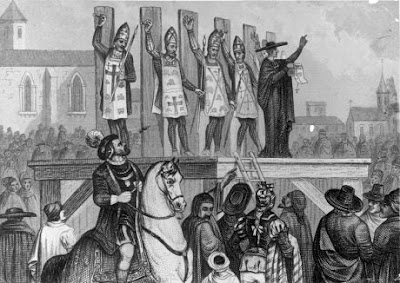35 Brutal facts of Goa Inquisition (Christian Terrorism) – Portuguese Colonial period
Posted on July 2nd, 2019
navrangindia.blogspot.com

Inquisition in Goa, India.www.maayboli.com

Hindu, Muslim, Jews, &Christians… bharatabharati.wordpress.com
In the annals of world history, the period of “The Inquisition” introduced by Portuguese rulers of Goa, India was the worst and scary chapter no body can ever think of, all in the name of Christ, an embodiment of love and compassion. In 1542, Fr. Francis Xavier, co-founder of the Society of Jesus, arrived in Goa with a view to taking the message of Christ among the native Indians who followed altogether different religions. He observed that the newly converted Christians were still practicing their old customs and traditions and were not serious about following the true Christian faith. Indian Christians, having turned a deaf ear to the European missionaries’ clarion call and subsequent warning, kept joyfully following their traditional Indian customs. Terribly disappointed, Fr. Francis Xavier took the extreme recourse available for him and he, at last, asked the Portuguese government in Portugal to introduce the most dreaded Inquisition in Goa, then a citadel of Portuguese power in India. He urged King John the III of Portugal to set up the Inquisition in Goa also to suppress Judaism because Jews refused to reconvert to Roman Catholicism. There was also Jewish population present in the other colonies in the west like Cochin and Goa.

Pope to apologise Protest in New York city.. 09/2015 Goan inquisition www.justiceforhindus.org
relics of St Francis Xavier,Basilica of Bom Jesus church Goa.
ians.in
Fr. Francis Xavier’s embalmed mortal remains are today kept in a silver casket inside the Bom Jesus Basilica in Goa and are taken out for public viewing every ten years. It is unfortunate that those thousands who come there to do their prayers reverentially to get his blessings had no idea whatsoever about him, who was responsible for the horrible atrocities he had let lose on the innocent people in ten of thousands, including Muslims, Jews and Hindus, many of whom were tortured to death and whose families underwent untold miseries and pain in the loss of their loved ones.
The following are the disgusting and, nauseating facts of Goa Inquisition during the Portuguese colonial period:
01. It is estimated that by the end of the 17th century, the Portuguese carried out ethnic cleansing of Hindus and Muslims who constituted less than 20,000 people who were non-Christians out of the total Goan population of 2,50,000. Among the severely punished – 4,046, out of whom 3,034 were men and 1,012 were women.
02. Indigenous people were forced to adhere to Portuguese religious beliefs, abandoning their faith.
03. The new Christian Missionaries from Portugal mandated that all Hindu temples be closed by 1541.
04. By 1559 Portuguese missionaries ordered the destruction of Hindu temples in that region. In 1567, in Bardez 300 Hindu temples were destroyed. From 1567 on Hindu rituals, including marriages and cremations, were banned for good. Everyone above 15 years of age was compelled to listen to Christian preaching, on pain of punishment.
05. With the introduction of Goa Inquisition-religious tribunal for suppression of heresy and punishment of heretics, whose prime architect was Fr. Francis Xavier, the situation turned worse for Hindus, Muslims and also for Jews. The latter were mostly traders.

06. Goa Inquisition was almost on par with Inquisition in Spain -1478 in terms of gory treatment and violence let lose in the name of religion.
07. Introduced in 1560, both Indian Christians and non-Christians went through hell and mental agony caused by Portuguese preachers in their mother land.

08. The beautiful Goa enclave with fine beaches and azure waters, in particular, became a horrible place of horrors of unimaginable proportion just for the simple reason that the natives refused to accept Portuguese religious beliefs and refused to get converted under compulsion or duress to Christianity.
09. Xavier commented “The Hindus are an unholy race. They are liars and cheats to the very backbone. Their idols are black—as black as black can be— ugly and horrible to look at , smeared with oil and smell in a evil manner…”
10. It is a paradox that Francis Xavier, the devil in the guise of a priest, who forced the King of Portugal to legally introduce the Inquisition in Goa and ordering the torture of tens of thousands of Hindus and Jews, using various innovative methods, was canonized by Pope Gregory XV in 1622.
11. Numerous Jewish families came to India to lead a peaceful life. Earlier they faced Inquisition in Spain and later in Portugal. They never thought the same fate would drive them to the wall here in India.
12. The preachers used many dreaded methods of torture to force the innocent people to swallow their preaching of Gospel . According to Richard Zimler, who wrote “Guardian of the Dawn” on Inquisition in Goa mentioned the missionaries used the machinery of death” for forceful conversion.

Portuguese Water boarding. bharatabharati.wordpress.com
13. Using torture, people were required to pass the ‘act of faith’ (auto-da-fe) by being stretched out on the rack. If not they would be burnt at the stake.
14. The following are the disgusting, brutal, inhuman punishments the faithfuls gave the gullible – tearing off the tongues, skinning of the accused alive, blinding the victim with sharp sticks or red-hot iron spikes, pulling of the flesh of victims hard with pliers and quartering – hammering a stake hard through the body (avoiding vital organs). Not be content with the above methods they used sharp iron fork to mangle breasts, red hot pincers to tear off flesh and red hot irons to insert up vagina and rectums.
15. Dismembering children limb by limb in front of their parents whose eyes were taped continued till they agreed to convert was the most cruel method used by the catholic faithfuls and they found this method very effective.
16. According to Zimler ” Over that period of 252 years, any man, woman, or child living in Goa could be arrested and tortured for simply whispering a prayer or keeping a small idol at home. Many Hindus — and some former Jews, as well — languished in special Inquisitional prisons, some for four, five, or six years at a time.”
17. In the Portuguese colonies, the government provided incentives for baptized Christians – rice donations for the poor, good positions in the Portuguese colonies for the middle class and military support for local rulers. Missionaries of the Society of Jesus acted as agents.
18. Even before Fr. Francis Xavier’s own letters about Inquisition sent to the king, missionaries, with glee, encouraged the destruction of Hindu temples and religious artifacts.
19. The Jews who secretly practiced Judaism, feigning Catholics were very much affected by Goa inquisition, in particular, Cochin Jews who began to migrate to deeper parts of Present day Kerala for survival.
20. The palace of Adil Shah, former ruler of Bijapur became the “palace of horror” where the Hindus who tried to flee the place with their deities were punished severely. There were special Inquisition prisons for the offenders of religion. Aleixo Dias Falcão and Francisco Marques were the ones who chose the palace as their venue to punish the apostates and heretics as well.
21. Possession of a small idol of a Hindu God, or a whispering prayer in Hebrew by the small Jewish community means serious trouble. Even Muslims had similar fate awaiting them.
22. Death awaited those non Christians or heretics (kept in shackles by priests) who refused to give up their faith or divulge the names of those who are non Christians. Death was by strangulation or burning alive in public Acts of Faith. These atrocities continued till 1812 until inquisition was finally abolished.
23. Hindus were not allowed to have Tulsi (basil plant, considered holy by the Hindus) maadam in their houses. Brahmin’s were forced to remove their tuft. The Portuguese colonial administration enacted anti-Hindu laws aimed at encouraging conversions to Christianity. The public worship of Hindu gods was made unlawful.
24. As for converted Christians, they were forced to say the prayers in Portuguese. Indian preachers were compelled to learn Portuguese to give their services in that language, not in their mother tongue – Konkani.Konkani language faced decline.
25. Numerous Gowda Saraswat Brahmins were forced to become Christians and were compelled to follow the western diets. Consequently numerous converted Gowda Saraswat Brahmins migrated to Mangalore (in Karnataka) and other regions. The Hindu Gowda Saraswat Brahmins, who escaped the religious persecution, also moved over to southern Canara. Part of the community moved farther down to Kochi and settled down there in places like Mattancherry..
26. Francis Buchanan, a Scottish physician, who visited Canara in 1801, in his book, ‘A Journey from Madras through the Countries of Mysore, Canara and Malabar (1807)’, stated that ” Goan Christians – roughly 8000 left Goa, came and settled in South Canara at the invitation of the King of Bednore.
In 1664 and later, the Maratha rulers’ invasions also one of the causes of exodus of Indian Christians. The Marathas were under the wrong impression that the native Christians were hostile to the Hindu population and forced them to convert to Christianity.
28. The inquisition was headed by a judge from Portugal who was answerable to (and only to) the General Counsel of the Lisbon Inquisition. He handed down punishments in line with the Rules that governed that Inquisition. The Inquisition was used as an instrument of social control, aiming at spreading Christian faith as followed by the Portuguese and Inquisition proceedings were conducted in secret.
29. Because of secrecy maintained by the Inquisition council and subsequent destruction of the records, numerous instances of atrocities inflicted by the Portuguese God men on Indian natives were not brought to light.
30. Da Fonseca recorded the violence and brutality of the inquisition. He mentioned the need for hundreds of prison cells to accommodate the accused. Those convicted of lesser crimes had to work in ship galleys and gunpowder factories.
31. Hindus were not allowed to enter the capital city on horseback or palanquins. Nor were they allowed to keep Hindu Gods’ images or idols at home. Christians were instructed not to employ Hindus for any purpose. Violations against the royal orders resulted in imprisonment.
32. Viceroy António de Noronha issued an order which applied to the entire area under Portuguese rule:
“I hereby order that in any area owned by my master, the king, nobody should construct a Hindu temple and such temples already constructed should not be repaired without my permission. If this order is transgressed, such temples shall be, destroyed and the goods in them shall be used to meet expenses of holy deeds, as punishment of such transgression.”
33. In 1620, legislation was passed prohibiting the Hindus from performing weddings. At the instigation of Franciscans, the PortugueseViceroy banned the use of Konkani in 1684, decreeing that within three years, the local people should speak the Portuguese tongue and use it in all their dealings in Portuguese territories. If not obeyed, people will face imprisonment.
34. Those who persistently refused to give up their ancient Hindu practices were declared apostates or heretics and condemned to death. In 1736, over 42 Hindu practices were prohibited.
35. The Inquisition did not leave the local Jews and Syrian Christians in Kerala, representatives of an early Christian tradition older than Roman Catholicism, that survives today as the Jacobite Christianity. In 1599 the Synod of Diamper authorized the forceful conversion of the “Syriac Saint Thomas Christians.”St. Thomas established the first seven and half churches in the coastal Kerala way back in 52 AD. The St. Thomas Christians also became the victims of Goa Inquisition because Syriac Christians later swore the “Coonan Cross Oath,” severing relations with the Catholic Church.
Ref:
Salomon, H. P. and Sassoon, I. S. D., in Saraiva, Antonio Jose. The Marrano Factory. The Portuguese Inquisition and Its New Christians, 1536–1765 (Brill, 2001), pp. 345–7.
T. R. de Souza. “The Goa Inquisition”. VG Web. Retrieved 1 November 2012.